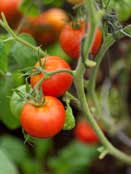
Whether you buy your red bell peppers conventionally grown from Chile or organically farmed down the road, you are likely noticing that food prices are rising faster than inflation. This just adds another layer to the already complicated question of, “What am I willing to pay for my food?” Every time I’m at the grocery store, and more so now that I live in a rural area with higher mark-ups, I ask myself this question. I’m starting my new Growing Dome garden in a couple of months and have already started to wonder how much I’ll be paying for soil, seeds, and starts. I believe deeply that one shouldn’t be frugal with something as important as the sustenance that provides life, but in the moment it can be hard to not feel like a lush when indulging in a three dollar bag of organic cheese puffs.
Recent studies have shown that around two-thirds of Americans are buying organic produce at least on occasion, and they’re willing to pay more for it (2, 3). With the recession and concern about food shortages some of you may be questioning your choice to go or stay organic. Here are some suggestions on how to reconcile the cost versus value of your food:
1. Trust Your Intuition, Monitor How You Feel
No matter how much we intellectualize food, count calories and read labels, consuming food is in essence a tangible experience. Do a study on yourself and really pay attention. Try all locally-grown and/or organic food for a week and then try all conventional food for a different week and take note of your energy level and moods along the way. If you’ve been there, done that, then spend some time reflecting on the experiences that have shaped your beliefs. The story of Paul Renner and Peaceful Gardens is a great testimonial for how organic and homegrown food equates to better health.
2. Decide Where You Enjoy Putting Your Time and Energy
The ease of buying organic food at a higher price may make up for the time you don’t want to invest in shopping around or growing it yourself. If today you’d rather go to the yoga studio than to the Saturday market, be who you are and do what you love. If you adore people, Community Supported Agriculture (CSA) programs and farm stands/markets are where you can direct your efforts. If you enjoy playing outdoors, then gardening is your deal and you’ll save money and get in shape by investing your time. Choose the direction that sparks your fancy and the happiness will erase the doubt.
3. Think of the Cost on a Global Scale
With food being shipped thousands of miles, your decisions have costs elsewhere. The healthcare and environmental costs associated with pesticide use are estimated around $12.5 billion annually. The public and environmental costs associated with soil erosion from conventional farms are thought to be in excess of $45 billion annually (2). If you buy local and/or grow your own food then you are significantly reducing fossil fuel use as well. Know that you are making a difference with your choices.
4. It’s Not About the Money
A couple of months ago we sent a survey out to current Growing Dome owners and asked what they use their Growing Dome for. The top two uses of the Growing Domes were a home garden and a sanctuary (place to relax). This shows us that food is not only about how to fuel our bodies, but is also about how we love and nurture ourselves. Don’t try too hard to put a price tag on that.
Author: Stacey Couch
